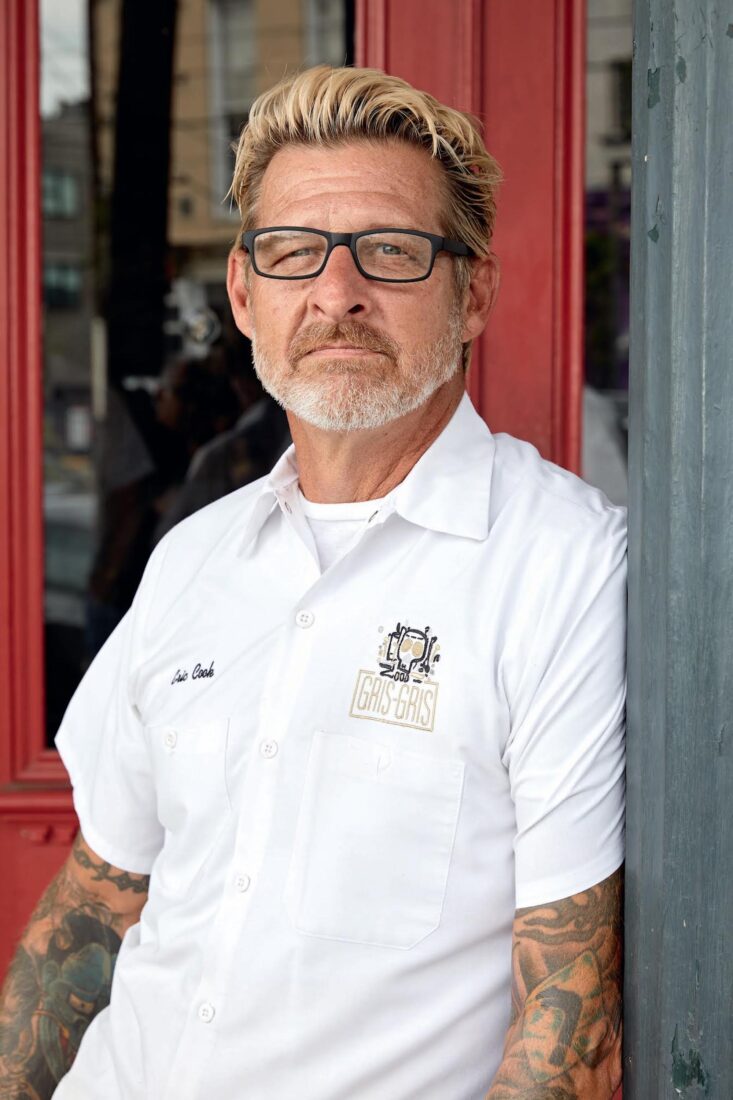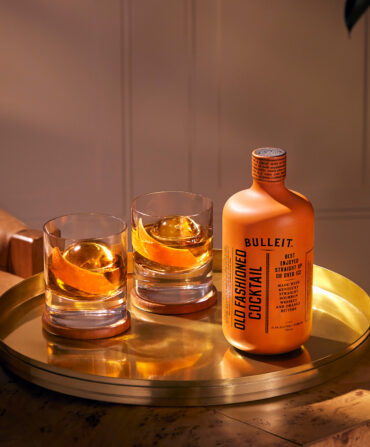Before he opened the beloved New Orleans restaurants Saint John and Gris-Gris, before he cooked for the president of the United States, before he joined the Marines, Eric Cook remembers sitting at the dinner table with his family, eating fresh-caught redfish, slow-cooked white beans, or shrimp and mirliton dressing.

His soon-to-be-released cookbook, Modern Creole: A Taste of New Orleans Culture and Cuisine (out September 17), is a reflection of those comforting meals along with his experience working in some of the city’s most iconic restaurants (Brennan’s, Commander’s Palace) and opening spots of his own. “I have so many memories of my family coming around the table for special occasions, eating things that we were so lucky to have around us in South Louisiana, like fresh fish and crab and Creole tomatoes and mirlitons,” he says. “This cookbook is a snapshot of home cooking, which has become famous in our restaurants because it’s what we enjoy cooking for our families here in New Orleans.”
Cook’s mother’s recipe for chicken and dumplings—his go-to birthday request as a kid— appears in the book, as does his take on Bananas Foster, created at Brennan’s. There are classics like gumbo and crawfish étouffée and chicken clemenceau; a fried trout almondine and whole redfish; a suite of cocktails, including a spiced-rim French 75; and artichoke boulettes dipped in a green remoulade “so good I’d eat a shoe dipped in it.”
Below, we caught up with the chef on the book—and what it was like transitioning from being a Marine to working in restaurants, the difficulty of photographing home cooking, the evolution of his oyster BLT, and the importance of being a good neighbor.
What was the inspiration behind the cookbook?
I remember my mom and my grandmother having cookbooks everywhere in the kitchen. As I got into the industry, I started collecting as well, and I’ve got this massive collection of books. When we got hit with the shutdown during the pandemic, I had a bunch of time on my hands, and I just started putting pieces together to make my own. It brought back so many memories of the adventures I’ve had in my career, from being a line cook at Commander’s and Brennan’s, opening my own restaurants, everything. There’s the cookbook stuff and then there’s crazy, hilarious stories behind the recipes—like when we cooked for the president of the United States, went out that night to celebrate, and ended up getting in a bar fight.
Let’s talk about the photography. I loved seeing how Sam Hanna brought the food to life.
With the food I cook, a lot of times it’s tough to photograph. It’s usually brown on brown. We had to figure out ways to make some of these dishes pop because a lot of it is home cooking. Many nights at 1:00 in the morning Sam would be like, ‘Hey, can you meet me at the restaurant at 7:00 in the morning? I have an idea.’ There was one day when we both passed the same piece of wood on the street driving into work to the restaurant. I was like, ‘Man, I almost stopped.’ He said, ‘I saw that and I almost stopped, too.’ So I drove back and picked up this piece of wood on the side of the road, and it pops up in the backgrounds, under sauté pans, things like that. Sam has such a great eye, and we shared the same vision for what this would be.
In the introduction, you talk about how your time as a Marine prepared you for restaurant life.
I knew I was joining the Marines at an early age in high school. I just wanted to get out of town. I went through my active duty and then coming out of the Gulf War, we had a transition in the White House. Our unit got cut. I didn’t have any plans, I didn’t know what to do, and all of a sudden I found myself back in New Orleans. My oldest sister introduced me to her best friend’s husband, who went to [school] with one of the Brennans who ran Brennan’s Restaurant. That’s the New Orleans way—everybody knows everybody. They brought me in and put me in the kitchen. At that point, I don’t think I’d eaten at a restaurant more times than I could count on my hand, much less worked in one.
But I immediately understood that there was structure, there was discipline. There was the chef, and under him was his chef de cuisine, his sous chefs. Behind the scenes, the industry can be a violent, vulgar world with this amazing camaraderie, and that was very familiar for me coming out of the infantry in a combat action Marine Corps unit. People were barking orders at you, coming at you from everywhere. “Yes sir” to “yes chef” was an easy transition.
You’ve been really intentional about giving back to the community, especially the veteran community, by working with organizations like Wounded Warriors, Veterans of Foreign Wars, and founding the First to Fight Foundation.
The Marines aren’t only a world-class fighting force, we’re also very much a humanitarian operation. We sometimes had to become humanitarian workers, helping people rebuild homes, rebuild businesses, providing food, providing shelter, providing protection, providing medical care. That’s not that separated from how we are here in New Orleans. This is a very tight-knit community that’s been through its share of not only natural disasters like Katrina but man-made disasters too, like the BP oil spill. I always wanted to be part of something that gave back during those times. I think the first step of becoming a good restaurant is to become a good neighbor.
Going back to the cookbook…do you have any favorite recipes?
The white bean cassoulet. It’s comfort food. My mom would cook white beans for us and leave them on the stove, and it was something we could feed on for days as a big family. It’s a one-pot thing but has so many flavors. At Commander’s Palace we used to do buttermilk biscuits with Ponchatoula strawberries and whipped cream. It’s a play on strawberry shortcake, but you have these great Southern biscuits as your base. My daughter absolutely loves that dish. And then the seafood: The shrimp and mirliton dressing, the stuffed flounder. Those remind me of my dad going fishing and hunting with his buddies and coming back with fresh game and fish. He would always set the table with a huge platter in the middle and we’d all eat family style.
Tell me about the oyster BLT.
The oyster BLT goes all the way back to when I was the executive chef of the National WWII Museum’s American Sector, and we used to do events once a month. I had a dinner series called Dinner After Dark, and we would invite eighty folks for five courses. We got these beautiful tomatoes from a farm over the North Shore. We were butchering whole hogs, so that’s where the pork belly came into it. There was a po’boy shop uptown that used to run a po’boy called the Peacemaker, and it was an oyster po’boy with bacon on it. So we paired the fried oysters with the pork belly, added tomato jam and arugula. When you put it all together you’ve got a sweet-tart tomato jam and then that smoky, fatty pork belly, the briny, crunchy oysters topped with earthy, peppery arugula. Then to top it off, it’s got sugar-cane vinegar for a little acid and that finish. It’s something I’ve been carrying with me for years, and I don’t think I’ll ever let it off the menu.
We have to talk about the great cocktails in here, like the Kréyole 75.
New Orleans is known for throwing a party. No matter what we’re doing, there’s usually a good cocktail that’s involved. It used to be that food was always paired with wine. Now, the bar scene has never been better in New Orleans, and we can reverse that thinking and pair food with cocktails. The Kréyole 75, with its spiced rim, lends itself to big, bright seafood dishes, like a seared redfish.
What do you hope people take away from the cookbook?
Generations before me in New Orleans enjoyed this city’s great culinary history. Everyone’s got family heirlooms of recipes passed down. I want to come in and say, yes, Creole cooking was here before me, but it’s also happening right now. I hope the book sparks people to get back into the kitchen and maybe bring back some of the memories they have of family meals. A lot of folks here around the city have fond memories of gumbo and dirty rice and whole fish. All these dishes share a place on our kitchen tables, and I hope this cookbook gets people cooking and making their own memories.
Garden & Gun has an affiliate partnership with bookshop.org and may receive a portion of sales when a reader clicks to buy a book.








